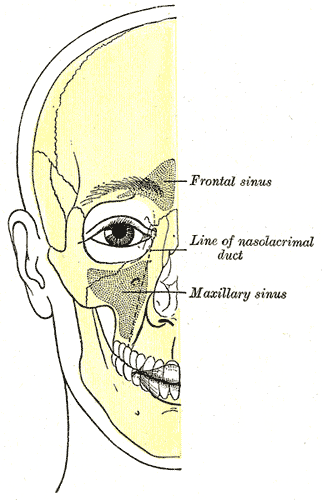നേസോലാക്രിമൽ ഡക്റ്റ്
| നേസോലാക്രിമൽ ഡക്റ്റ് | |
|---|---|
 The lacrimal apparatus. Right side. | |
 Outline of bones of face, showing position of air sinuses. | |
| Details | |
| Identifiers | |
| Latin | Ductus nasolacrimalis |
| MeSH | D009301 |
| TA | A15.2.07.070 |
| FMA | 9703 |
| Anatomical terminology | |
കണ്ണിന്റെ ലാക്രിമൽ സഞ്ചിയിൽ നിന്ന് നേസൽ കാവിറ്റിയിലേക്ക് കണ്ണുനീർ കൊണ്ടുപോകുന്ന നാളിയാണ് നേസോലാക്രിമൽ ഡക്റ്റ് (ടിയർ ഡക്റ്റ് എന്നും അറിയപ്പെടുന്നു) എന്ന് അറിയപ്പെടുന്നത്.[1][2] മാക്സില്ലറി, ലാക്രിമൽ അസ്ഥികൾക്കിടയിലുള്ള കണ്ണ് സോക്കറ്റിൽ നിന്ന് നാളം ആരംഭിക്കുന്നു, അവിടുന്ന് അത് അവിടെ നിന്ന് താഴോട്ടും പിന്നോട്ടും പോകുന്നു. നാളി, നാസികാ ദ്വാരത്തിലെ മ്യൂക്കോസൽ മടക്കുകളാൽ (വാൽ ഓഫ് ഹാസ്നർ അല്ലെങ്കിൽ പ്ലിക്ക ലാക്രിമാലിസ്) ഭാഗികമായി മൂടപ്പെട്ട ഇൻഫീരിയർ നേസൽ മീറ്റസിലേക്ക് തുറക്കുന്നു.[3]
അധികമായി ഉത്പാദിക്കപ്പെടുന്ന കണ്ണുനീരാണ് നാളത്തിലൂടെ മൂക്കിനുള്ളിലെ നേസൽ മീറ്റസിലേക്ക് ഒഴുകുന്നത്. ഒരു വ്യക്തി കരയുമ്പോഴോ അലർജിയിൽ നിന്ന് കണ്ണുകളിൽ വെള്ളം നിറയുമ്പോഴൊ മൂക്കൊലിപ്പ് ഉണ്ടാകുന്നത് ഇതു കാരണമാണ്. ചില കണ്ണിലൊഴിക്കുന്ന തുള്ളിമരുന്നുകൾ കണ്ണിൽ നിന്ന് നേസൽ കാവിറ്റിയിൽ എത്തി അനാവശ്യ പാർശ്വഫലങ്ങൾ ഉണ്ടാകുന്നത് തടയാൻ അത്തരം തുള്ളിമരുന്നുകൾ കണ്ണിൽ പ്രയോഗിക്കുമ്പോൾ, കണ്ണിനു താഴെ വിരലുകൊണ്ട് അമർത്തി നേസോലാക്രിമൽ നാളം അടയ്ക്കാൻ ശുപാർശചെയ്യുന്നു.
ലാക്രിമൽ സഞ്ചിയിലെന്നപോലെ, മ്യൂക്കസ്-സ്രവിക്കുന്ന ഗോബ്ലറ്റ് സെല്ലുകൾ അടങ്ങിയ സ്ട്രാറ്റേറ്റഡ് കോളമ്നാർ എപിത്തീലിയമാണ് ഈ നാളിയിൽ ഉള്ളത്, അതിനു ചുറ്റും ബന്ധിത ടിഷ്യുവും ഉണ്ട്.
ക്ലിനിക്കൽ പ്രാധാന്യം
[തിരുത്തുക]നേസോലാക്രിമൽ നാളത്തിന് തടസ്സം സംഭവിക്കാം.[4][5][6] ഇത് എപ്പിഫോറ (ക്രോണിക് ലോ-ഗ്രേഡ് നേസോലാക്രിമൽ ഡക്റ്റ് ഒക്ലൂഷൻ) എന്നറിയപ്പെടുന്ന കണ്ണീരിന്റെ അമിതപ്രവാഹത്തിലേക്ക് നയിക്കുന്നു.[7] ജന്മനായുള്ള തടസ്സം നാളത്തിന്റെ സിസ്റ്റിക് വികാസത്തിന് കാരണമാകും, ഇതിനെ ഡാക്രിയോസിസ്റ്റോസീൽ അല്ലെങ്കിൽ ടിമോ സിസ്റ്റ് എന്ന് വിളിക്കുന്നു. വരണ്ട കണ്ണ് രോഗമുള്ളവർക്ക് ദ്രാവകത്തിൻ്റെ മൂക്കിലേക്കുള്ള ഒഴുക്ക് പരിമിതപ്പെടുത്താനും ഈർപ്പം നിലനിർത്താനും നാളങ്ങൾ അടയ്ക്കുന്ന പഞ്ച് പ്ലഗുകൾ ഘടിപ്പിക്കാം.
നേസോലാക്രിമൽ നാളം അടങ്ങിയിരിക്കുന്ന കനാലിനെ നേസോലാക്രിമൽ കനാൽ എന്ന് വിളിക്കുന്നു.
മനുഷ്യരിൽ, പുരുഷന്മാരിലെ കണ്ണുനീർ ഡക്റ്റുകൾ സ്ത്രീകളേക്കാൾ വലുതായിരിക്കും.[8]
അധിക ചിത്രങ്ങൾ
[തിരുത്തുക]-
ഇടത് നാസികാദ്വാരത്തിന്റെ മേൽക്കൂര, തറ, പാർശ്വസ്ഥ മതിൽ എന്നിവയുടെ ചിത്രീകരണം
ഇതും കാണുക
[തിരുത്തുക]അവലംബം
[തിരുത്തുക]- ↑ "Nasolacrimal System Anatomy: Embryology, Puncta, Canaliculi". 2020-02-19.
{{cite journal}}: Cite journal requires|journal=(help) - ↑ Herbert, Ronald A.; Janardhan, Kyathanahalli S.; Pandiri, Arun R.; Cesta, Mark F.; Miller, Rodney A. (2018). "Nose, Larynx, and Trachea". Boorman's Pathology of the Rat. Elsevier. pp. 391–435. doi:10.1016/b978-0-12-391448-4.00022-8. ISBN 978-0-12-391448-4.
The paired nasolacrimal ducts carry lacrimal secretions from the eye to the nasal cavity, and originate as oval openings near the edge of the medial canthus of the eyelids. Initially the duct is small and circular, but in the middle portion, the diameter increases and the appearance is more oblong and saccular. The diameter again decreases before the duct enters the ventrolateral nasal vestibule medial to the root of the incisor tooth approximately 2 mm caudal to the nares.
- ↑ "Medical Definition of PLICA LACRIMALIS". Merriam-Webster Medical Dictionary. 2020-05-08. Retrieved 2020-05-08.
an imperfect valve at the opening of the nasolacrimal duct into the inferior meatus of the nose
- ↑ CARREIRO, J (2009). "Head and neck". Pediatric Manual Medicine. Elsevier. pp. 13–97. doi:10.1016/b978-0-443-10308-7.00002-8. ISBN 978-0-443-10308-7.
Dacryostenosis is a condition whereby the nasolacrimal duct is narrowed or blocked and the glandular secretions into the eye are prevented from draining properly. The secretions collect around the orifice of the duct and in the corner of the eye, where they thicken, resulting in a gooey, sticky substance that further clogs any drainage route.
- ↑ Stagner, Anna M.; Jakobiec, Frederick A.; Eagle, Ralph C.; Charles, Norman C. (2018). "Infections of the Eye and Its Adnexa". Diagnostic Pathology of Infectious Disease. Elsevier. pp. 648–685. doi:10.1016/b978-0-323-44585-6.00021-7. ISBN 978-0-323-44585-6.
Dacryocystitis is produced by obstruction of the nasolacrimal duct with resultant tear stasis. Clinically, patients display erythema and swelling of the lacrimal sac, creating a mass in the medial canthal area, centered below the medial canthal tendon.
- ↑ "Blocked tear ducts in infants" Archived 2012-07-08 at the Wayback Machine., Pediatric Views, June 2006.
- ↑ Nerad, Jeffrey A.; Carter, Keith D.; Alford, Mark (2008). "Disorders of the Lacrimal System: Congenital Obstruction". Oculoplastic and Reconstructive Surgery. Elsevier. pp. 131–137. doi:10.1016/b978-0-323-05386-0.50010-7. ISBN 978-0-323-05386-0.
- ↑ "Tears of Men and Women Are Different", Wall Street Journal, mirrored at "Why Men and Women Shed Different Tears", Fox News, May 5, 2011.
പുറം കണ്ണികൾ
[തിരുത്തുക]- Anatomy figure: 33:04-09 at Human Anatomy Online, SUNY Downstate Medical Center
- lesson9 at The Anatomy Lesson by Wesley Norman (Georgetown University)
